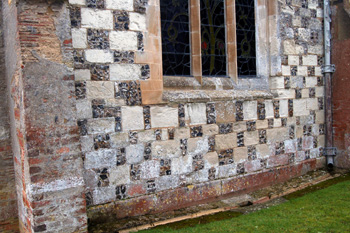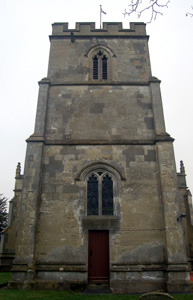Totternhoe Church Architecture

Totternhoe church from the south-east December 2008
It seems reasonable to assume that there has been a church in Totternhoe since at least the late Anglo-Saxon period but it is only known for certain that there has been a church at Totternhoe since the 13th century as the list of incumbents goes back to 1220.
Saint Giles' church is, as one might expect, largely built of Totternhoe clunch, which, though easy to work, weathers badly. The east end of the chancel has squares of clunch and flints arranged in a chewuerboard fashion, quite common in the area. The chancel of the current church dates from the 14th century, about a century after the earliest known vicar, and this is the earliest surviving part of the building.

Flint and Totternhoe stone chequerboard work on the east end of the church February 2010
The rest of the church is Perpendicular and dates from the late 15th or early 16th century. The building comprises a chancel, nave with north and south aisles, west tower and north vestry. The roofs of the nave and aisles are original with carved beams and bosses.
The Ashwell family ensured that the church was restored in the late 15th century. This is confirmed by the capital on the east respond of the north arcade which bears the symbol of an angel with s shield depicting an ash tree rising from a well. The will of William Ashwell of 1545 leaves money (£3/6/8) to build the west tower [ABP/R11]. Interestingly, despite being made at the reign of Henry VIII when the Protestant party at court was in the ascendancy Ashwell asked "to be buried in the church of Toternehoo before the image of Our Blessed Lady".
The rood screen dates from the 15th century. There are some old benches which may be late 15th or early 16th century and the font is Perpendicular (i.e. between about 1335 and 1530).
 Totternhoe church from the west December 2008
Totternhoe church from the west December 2008